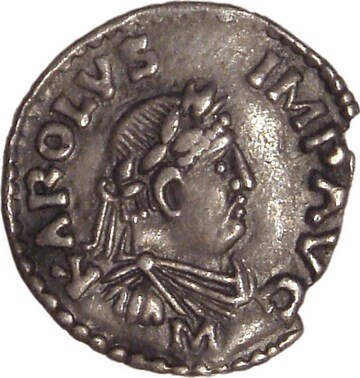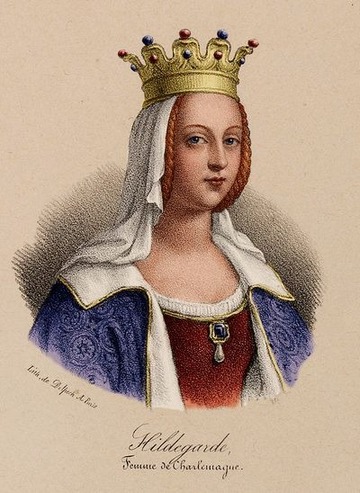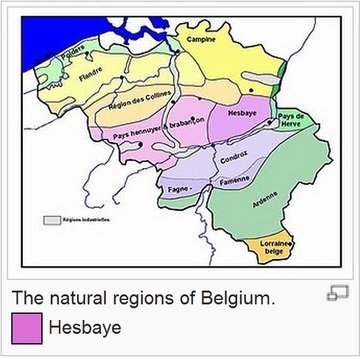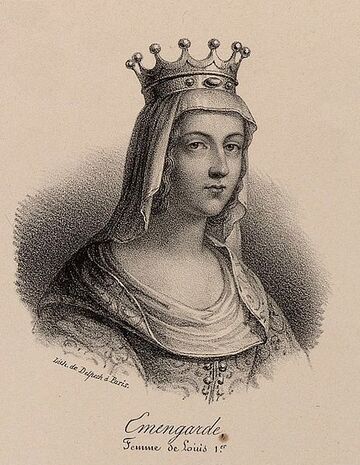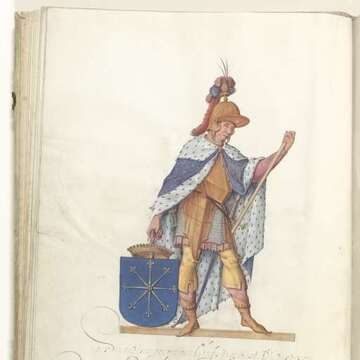maximum test » Hildegarde "Carolingian daughter of Louis I & Ermengard" d'Aquitaine Abbesse de Saint-Jean-de-Laon (± 802-860)
Personal data Hildegarde "Carolingian daughter of Louis I & Ermengard" d'Aquitaine Abbesse de Saint-Jean-de-Laon
Source 1- Nickname is Carolingian daughter of Louis I & Ermengard.
- She was born about 802Aquitaine France.
- She was christened in From Ancestral Roots line 144A #15.
- Alternative: She was christened in the year 801 in France.
- Baptized (at 8 years of age or later) by the priesthood authority of the LDS church on May 25, 1954.
- Alternative: Baptized (at 8 years of age or later) by the priesthood authority of the LDS church on May 25, 1954.
- Alternative: Baptized (at 8 years of age or later) by the priesthood authority of the LDS church on May 25, 1954 in ALBER.
- Alternative: Baptized (at 8 years of age or later) by the priesthood authority of the LDS church on May 25, 1954.
- Occupations:
- unknown.
- Abdesse van Notre Dame,Laon, F.
- unknown.
- Unknown GEDCOM info: Som enke abbedisse i Notre Dame i Laon Unknown GEDCOM info: 0.
- unknown in Abbess of Leon.
- She died on August 23, 860 in Abbaye Saint-Jean de LaonLaon
(Present Picardie) Carolingian Empire (Present France). - She is buried in an hitherto unknown dau. of Louis I &, Ermengarde.
- A child of Louis I I and Ermengarde de Hesbaye
Household of Hildegarde "Carolingian daughter of Louis I & Ermengard" d'Aquitaine Abbesse de Saint-Jean-de-Laon
She had a relationship with Boudewijn van Kleef en Teisterbant.
Child(ren):
Notes about Hildegarde "Carolingian daughter of Louis I & Ermengard" d'Aquitaine Abbesse de Saint-Jean-de-Laon
Name Suffix:Of The Holy Roman Empire
!Name is; Hildegarde, Princess of The /HOLY ROMAN EMPIRE/
Kilde: Weis, Frederick Lewis, Ancestral Roots of Sixty Colonists, 6th
Edition, Baltimore: Genealogical Publishing Co, 1988.
Kilde: parents: [Ref: Weis AR #144A] Kilde: names: Gerard of AUVERGNE &
unk daughter of Louis I & Ermengarde [Ref: Weis AR #144A]
{geni:about_me} [https://www.geni.com/people/Hildegarde-d-Aquitaine-Abbesse-de-Saint-Jean-de-Laon/6000000002188113581?through=6000000001266578142 HILDEGARD]''' ([802/04]-857, or maybe after [23 Aug 860]). The Genealogica Arnulfi Comitis names (in order) "Hlotharium Pipinum et Hludovicum Rotrudim et Hildegardim" as children of "Hludovicus ymperator…ex Yrmingardi regina"[217]. Hildegard is named as sister of Charles by Nithard[218]. Abbess of Notre-Dame and Saint-Jean at Laon. She supported her brother Lothaire against her half-brother Charles and, in Oct 841, imprisoned Adalgar at Laon. After Laon was besieged, she surrendered Adalgar but was herself released by her half-brother206. The Annales Formoselenses record the death in 857 of "Hildegard, Lothawici regis filia"[219], corroborated in the Annales Alemannici[220]. http://fmg.ac/Projects/MedLands/CAROLINGIANS.htm#LouisIEmperorB
-------------
2nd wife of Gerard, Count of Auvergne,
who married first Rotrude, daughter of Louis the Pious (they had 3 children).
Then he married her sister Hildegard (they had no children).
http://en.wikipedia.org/wiki/Gerard,_Count_of_Auvergne
It cites as it's source:
http://www8.informatik.uni-erlangen.de/cgi-bin/stoyan/l1/LANG=engl/INDEX=I220276
From http://a-e-g.chat.ru/trees/caroling/142.htm
Hildegarda - Abbess of Laon (841-?)
Hildegarde abbesse de Laon
epouse: Gerard co comte d"Auvergne. mort en 841. cf: Dynastie Guilhemide, Dynastie d"Aquitaine
---
(Ben M. Angel comments: Unfortunately "Stoyan" doesn't cite any sources for his information. FMG maintains as yet that there is no marital connection or children.)
-------------------------
From the Foundation for Medieval Genealogy page on Carolingian Kings (covering her birth family - her mother was Ermengard):
http://fmg.ac/Projects/MedLands/CAROLINGIANS.htm#_Toc240955193
LOUIS [Hludowic], son of CHARLES I King of the Franks & his second wife Hildegard (Chasseneuil-du-Poitou {Vienne}
Emperor Louis I & his first wife (ERMENGARD) had six children:
1. LOTHAIRE [Lothar] (795-Kloster Prüm 29 Sep 855, bur Kloster Prüm).
Thegan's Vita Hludowici Imperatoris names (in order) "Hlutharius, Pippinus, Hludowicus" as sons of Emperor Ludwig I & his wife Ermengard[200].
He was crowned joint Emperor LOTHAIRE I, jointly with his father, in Jul 817 at Aix-la-Chapelle.
2. PEPIN ([797]-Poitiers 13 Dec 838, bur Poitiers, église collégiale de Sainte-Radégonde).
Thegan's Vita Hludowici Imperatoris names (in order) "Hlutharius, Pippinus, Hludowicus" as sons of Emperor Ludwig I & his wife Ermengard[201].
Under the Ordinatio Imperii promulgated by his father at Worms in 817, he became PEPIN I King of Aquitaine.
'''3. HROTRUD [Rotrude] ([800]-).
The Genealogica Arnulfi Comitis names (in order) "Hlotharium Pipinum et Hludovicum Rotrudim et Hildegardim" as children of "Hludovicus ymperator…ex Yrmingardi regina"[202].'''
4. BERTA .
Settipani cites charters which name Berta as the daughter of Emperor Louis[203].
'''5. HILDEGARD ([802/04]-857, or maybe after [23 Aug 860]).
The Genealogica Arnulfi Comitis names (in order) "Hlotharium Pipinum et Hludovicum Rotrudim et Hildegardim" as children of "Hludovicus ymperator…ex Yrmingardi regina"[204]. Hildegard is named as sister of Charles by Nithard[205].
Abbess of Notre-Dame and Saint-Jean at Laon.
She supported her brother Lothaire against her half-brother Charles and, in Oct 841, imprisoned Adalgar at Laon. After Laon was besieged, she surrendered Adalgar but was herself released by her half-brother.
The Annales Formoselenses record the death in 857 of "Hildegard, Lothawici regis filia"[206], corroborated in the Annales Alemannici[207].'''
---
6. LOUIS ([806]-Frankfurt-am-Main 28 Aug 876, bur Kloster Lorsch).
Thegan's Vita Hludowici Imperatoris names (in order) "Hlutharius, Pippinus, Hludowicus" as sons of Emperor Ludwig I and his wife Ermengardis[208].
Under the Ordinatio Imperii promulgated by his father at Worms in 817, he became King of Bavaria and Carinthia. Under the partition of territories agreed by the Treaty of Verdun 11 Aug 843, Louis was installed as LUDWIG II "le Germanique/der Deutsche" King of the East Franks.
Emperor Louis I & his second wife (JUDITH) had [three] children:
7. GISELA ([819/822]-after 1 Jul 874, bur Cysoing, Abbey of St Calixtus).
The Genealogica Arnulfi Comitis names (in order) "Karolum et Gislam" children of "Hludovicus ymperator…ex Iudith ymperatrice"[209]. Her marriage is deduced from a charter in which Gisela states that their eldest son Unruoch brought back the body of Eberhard from Italy[210].
She founded the abbey of St Calixtus at Cysoing, Flanders, where she lived as a widow.
"Gisle" granted "le fisc de Somain en Ostrevant" to "filii…Adelarde" by charter dated 14 Apr 869, which names "rex Karolus meus…germanus…senioris mei dulcis memorie Evrardi…tres infantes meos Rodulfum…et Berengarium…et…Adelarde"[211]. The Historia Ecclesiæ Cisoniensis records that “Gisla” donated property to Cysoing abbey for her burial next to “coniugis mei dulcis memoriæ Evrardi”, by charter dated 2 Apr 870 which names “filiæ meæ Ingiltrudis…filius meus Rodulfus”, and by charter dated “Kal Jul anno XXXV regnante Carolo Rege”, naming “filii mei Unroch…filiorum meorum Adalardo atque Rodulfo” and signed by “Odelrici Comitis”[212]. "Gisle" donated property to Cysoing for the anniversaries of "Ludovico imperatore patre meo et…Judith imperatrice matre mea et…rege Karolo…germano et…prole mea…Hengeltrude, Hunroc, Berengario, Adelardo, Rodulpho, Hellwich, Gilla, Judith" by charter dated to [874][213].
m ([836]) EBERHARD Marchese di Friulia, son of UNRUOCH Comte [en Ternois] & his wife Engeltrude (-in Italy 16 Dec 866, bur Cysoing, Abbey of St Calixtus).
8. CHARLES (Frankfurt-am-Main 13 Jun 823-Avrieux or Brides-les-Bains, Savoie 6 Oct 877, bur Nantua Abbey, transferred to église de l'abbaye royale de Saint-Denis).
The Annales S. Benigni Divisionensis record the birth of "Karolus filius Ludowici" in Frankfurt "Idus Iun 824"[214]. Thegan's Vita Hludowici Imperatoris names Charles as son of his father by his second wife[215]. Under the division of Imperial territories by the Treaty of Verdun 11 Aug 843, he became CHARLES II “le Chauve” King of the West Franks.
9. [daughter .
The Casus Monasterii Petrishusensis records that "rex Francorum qui et imperator Romanorum" (which appears to indicate Charles II "le Chauve") gave his sister in marriage to "vir nobilissimo genere decoratus", that the couple had two sons to whom their uncle gave "in Alemannia loca…Potamum et Brigantium, Ubirlingin et Buochorn, Ahihusin et Turingen atque Heistirgou, Wintirture…et in Retia Curiensi Mesouch", and that one of the sons returned to France while the other "Oudalricus" retained all the property in Alamannia[216]. The editor of the MGH SS compilation dates this source to the mid-12th century[217]. The information has not been corroborated in any earlier primary source, although it is not known what prior documentation may have been available to the compiler of the Casus. There are several other difficulties with this marriage which suggest that the report in the Casus should be treated with caution. If the information is accurate, it is likely that the bride was a full sister of King Charles, although if this is correct her absence from contemporary documentation is surprising. If she had been Charles's half-sister, it is difficult to see how Charles would have had much influence on her marriage, which would have been arranged by one of her full brothers. In any case, it is unlikely that Emperor Louis's first wife would have had further children after [812/15] at the latest, given the birth of her eldest son in 795. If that estimated birth date is correct, then it is more likely that this daughter's marriage would have been arranged by her father Emperor Louis before his death in 840. Another problem is the potential consanguinity between the parties. Although the precise relationship between the couple's son Udalrich [III] and the earlier Udalrichinger cannot be established from available documentation, it is probable that he was closely related to Hildegard, first wife of Emperor Charles I, who was the paternal grandmother of Emperor Louis's children. Lastly, Udalrich [III] is recorded in charters dated 847 and 854, suggesting a birth date in the 820s assuming that he was adult at the time, which is inconsistent with Charles II "le Chauve" (born in 823) having arranged his parents' marriage.
m --- [Udalrichinger].]
Emperor Louis I had [two] illegitimate children by Mistress (1):
10. [ALPAIS ([793/94]-23 Jul 852 or after, bur [Reims]).
Flodoard refers to "Ludowicus Alpheidi filie sue uxori Begonis comitis"[218]. The Annales Hildesheimenses name "filiam imperatoris…Elpheid" as the wife of "Bicgo de amici regis" when recording the death of her husband[219].
Settipani discusses the debate about the paternity of Alpais, preferring the theory that Emperor Charles I was her father[220]. If Emperor Louis was her father, it is unlikely that she was born before [793/94], given his known birth date in 778. It would therefore be chronologically tight for her to have had [three] children by her husband before his death in 816. However, no indication has been found in primary sources of the age of these children when their father died.
The question of Alpais's paternity is obviously not beyond doubt, but it is felt preferable to show her as the possible daughter of Emperor Louis in view of the clear statement in Flodoard. No indication has been found of the name of Alpais's mother. If Alpais was the daughter of Emperor Louis, it is likely that she was not her husband's only wife in view of Bego's estimated birth date.
After her husband died, she became abbess of Saint-Pierre-le-Bas at Reims in [817]. She was still there 29 May 852.
m ([806]) [as his second wife,] BEGO, son of [GERARD [I] Comte de Paris & his wife Rotrud] ([755/60]-28 Oct 816).
He governed the county of Toulouse as "marchio" for Septimania in 806.
Comte de Paris in [815], succeeding comte Stephanus.]
11. ARNOUL ([794]-after [Mar/Apr] 841).
The Chronicon Moissacense names "quartum…filium [Ludovici]…ex concubina…Arnulfum" recording that his father gave him the county of Sens[221].
Comte de Sens 817.
He was a supporter of his half-brother Emperor Lothaire in [Mar/Apr] 841[222].
References:
[178] Nithard I.8, p. 140.
[179] Pauli Gesta Episcop. Mettensium, MGH SS II, p. 265.
[180] Settipani, C. and Kerrebrouck, P. van (1993) La préhistoire des Capétiens 481-987, 1ère partie, Mérovingiens, Carolingiens et Robertiens (Villeneuve d'Ascq), p. 250.
[181] RFA 813, p. 95.
[182] Settipani (1993), p. 252.
[183] Settipani (1993), pp. 252-3.
[184] Annales Fuldensium Pars Secunda, auctore Euodolfo 840, MGH SS I, p. 362.
[185] Annales Necrologici Prumienses, MGH SS XIII, p. 219.
[186] Libri Anniversariorum et Necrologium Monasterii Sancti Galli, Konstanz Necrologies, p. 462.
[187] Obituaires de Sens Tome I.1, Obituaire de Notre-Dame de Paris, p. 227.
[188] Obituaires de Sens Tome I.1, Abbaye de Saint-Denis, p. 320.
[189] RFA 818, p. 104.
[190] Thegani Vita Hludowici Imperatoris 4, MGH SS II, p. 591.
[191] Gesta quorundam regum Francorum 818, MGH SS I, p. 356.
[192] Vita Hludowici Imperatoris 31, MGH SS II, p. 623.
[193] Annales Xantenses 819, MGH SS II, p. 224.
[194] Thegani Vita Hludowici Imperatoris 26, MGH SS II, p. 596.
[195] Einhardi Annales 819, MGH SS I, p. 206.
[196] Thegani Vita Hludowici Imperatoris 36, MGH SS II, p. 597.
[197] Settipani (1993), pp. 254-5.
[198] Obituaires de Sens Tome I.1, Abbaye de Saint-Denis, p. 315.
[199] Annales Xantenses 843, MGH SS II, p. 227.
[200] Thegani Vita Hludowici Imperatoris 4, MGH SS II, p. 591.
[201] Thegani Vita Hludowici Imperatoris 4, MGH SS II, p. 591.
[202] Genealogiæ Comitum Flandriæ, Witgeri Genealogica Arnulfi Comitis MGH SS IX, p. 303.
[203] Settipani (1993), p. 255 footnote 446, citing MGH Dipl Carol, no. 48, p. 143, 101, 241, 197, p. 353, spur. 34, p. 441.
[204] Genealogiæ Comitum Flandriæ, Witgeri Genealogica Arnulfi Comitis MGH SS IX, p. 303.
[205] Nithard III.4, p. 160.
[206] Annales Formoselenses 857, MGH SS V, p. 35.
[207] Annales Alemannici 857, MGH SS I, p. 50 "Hludovici regis filia Hiltikart", footnote 1 referring to "Necrolog S Galli" recording "X Kal Dec".
[208] Thegani Vita Hludowici Imperatoris 4, MGH SS II, p. 591.
[209] Genealogiæ Comitum Flandriæ, Witgeri Genealogica Arnulfi Comitis MGH SS IX, p. 303.
[210] Coussemaker, I. de (ed.) (1886) Cartulaire de l´abbaye de Cysoing et de ses dépendances (Lille) ("Cysoing"), V, p. 10.
[211] Cysoing III, p. 7.
[212] Historia Ecclesiæ Cisoniensis, Spicilegium II, pp. 878 and 879, and Cysoing IV and V, pp. 8 and 10.
[213] Cysoing VI, p. 11.
[214] Annales S. Benigni Divionensis 824, MGH SS V, p. 39.
[215] Thegani Vita Hludowici Imperatoris 35, MGH SS II, p. 597.
[216] Casus Monasterii Petrishusensis I.2, MGH SS XX, p. 628.
[217] MGH SS XX, pp. 622-25.
[218] Flodoardus Remensis Historia Remensis Ecclesiæ IV, XLVI, MGH SS XXXVI, p. 448.
[219] Annales Hildesheimenses 815, MGH SS III, p. 42.
[220] Settipani (1993), pp. 200-02.
[221] Chronicon Moissacense 817, MGH SS I, p. 312.
[222] Settipani (1993), p. 255.
--------------------------
History of Laon from the French Wikipedia page on Laon:
http://fr.wikipedia.org/wiki/Laon
L’occupation permanente de la ville haute ne débute que vers le milieu du ier siècle av. J.-C. Nous n’avons, de Laon durant l’Antiquité, qu’une vision très sommaire. Le statut de la ville nous est totalement inconnu pour toute la période antique. Dans la ville basse, plusieurs sites gallo-romains sont attestés.
L’époque gallo-romaine est partout présente dans la ville haute, aussi bien pour le Haut Empire que pour le Bas Empire. Au moins pour l’Antiquité tardive, il est certain que le castrum a été fortifié, très probablement avec une muraille en maçonnerie. L’occupation du Bas Empire semble plus dense dans la Cité, à l’intérieur du castrum, que dans le Bourg.
Les premières traces de christianisme remontent au ve siècle, comme en atteste une pierre funéraire paléochrétienne découverte en 1998.
Moyen Âge
Entre 497 et 513, saint Remi9, natif de la région laonnoise, élève Laon à la dignité de cité par la création d'un évêché démembré de celui de Reims. Au xe siècle, au pouvoir épiscopal s’ajoute le pouvoir royal, Laon étant un lieu de résidence fréquent des derniers rois carolingiens.
Au vie siècle, la Cité se confond encore probablement avec le castrum du Bas Empire. En 580, le duc Loup de Champagne, a mis sa femme en sûreté à l'intérieur des murs de la ville de Laon (Grégoire de Tours, Historia Francorum, livre VI).
Le tracé des remparts de la Cité, reconstruits ou agrandis à l’époque carolingienne, est totalement inconnu. En dehors des murs de la Cité, à l’ouest, le peuplement se développe dans le secteur de l’église Saint-Julien. Un ou plusieurs noyaux de peuplement semblent également se développer sur le bras sud-ouest de la butte. En ville basse, le faubourg de Vaux existe probablement avant même le haut Moyen Âge et les faubourgs de Saint-Marcel, de Semilly et de Leuilly apparaissent peut-être à cette époque. Le faubourg d’Ardon semble assez tardif et encore quasi inexistant au xe siècle (le faubourg de La Neuville n'est fondé qu'à la fin du xiie siècle).
La Cité renferme la cathédrale, reconstruite dans le premier tiers du ixe siècle, la résidence de l’évêque et le cloître des chanoines au nord, et, au sud, le palais royal et l’abbaye saint Jean, un monastère double[10], fondé hors les murs par sainte Salaberge en 648 [11], ou 641 selon l'historien Dominique Barthélemy [12] et dédié à saint Jean-Baptiste [13],[14].
In English:
Permanent occupation of the upper city began in the middle of the 1st century BC. There exists only a brief summary about Laon in antiquity. The status of the city is totally unknown to us through the ancient period. In the lower town, several Gallo-Roman sites have been certified.
Gallo-Roman sites are everywhere in the upper city, both from the middle and late Roman period. At least for the late ancient period, it is certain that a fortified castrum existed, most likely with walls built of masonry. Late Roman sites seem denser in the city, inside the castrum, and in the village.
The first traces of Christianity date back to the 5th century, as evidenced by an early Christian gravestone discovered in 1998.
Middle Ages
Between 497 and 513, St. Remi [9], native of the Laon region, elevated Laon to the dignity of a city with the creation of a diocese separate from that in Rheims. To the 10th century, episcopal power and royal power rested in Laon as a place of residence for the last Carolingian kings.
In the 6th century, the city still was likely confused with the castrum from the late Roman Empire. In 580, the Duke Loup de Champagne and his wife took refuge within the walls of the city of Laon (Gregory of Tours, Historia Francorum, Book VI).
The layout of the city ramparts, rebuilt or expanded during the Carolingian period, are now totally unknown. Outside the walls of the city to the west, the settlement grew in the area of St-Julien. One or more population centers also seemed to have thrived to the southwest of the butte. The suburb of Vaux was probably existent even before the Middle Ages, and the suburbs of St-Marcel, Semilly, and Leuilly may have appeared at that time. The suburb of Ardon seems to have been created quite late and was still almost non-existent in the 10th century (the suburb of La Neuville was founded at the end of the 12th century).
The city contains a cathedral rebuilt in the first third of the 9th century, with a residence for the bishop and canons of the cloister to the north and south, the royal palace and the Abbey of St-Jean, a double monastery [10], located off the walls by Saint Salaberge in 648 [1] or 641, according to historian Dominique Barthelemy [12], and dedicated to St. John the Baptist. [13],[14].
References:
9. ↑ Suzanne Martinet, Laon promontoire sacré des druides au ixe siècle, p. 40; janvier 1994
10. ↑ Les amis de saint Colomban, Saint Bodon ou saint Leudin (Leudinus-Bodo), viie siècle
http://www.amisaintcolomban.net/attachments/File/Patrimoine_colombanien/saints/30_Bodo_Leudin2.pdf
11. ↑ Ville de Laon, service archéologique, Laon des origines à la Révolution
http://jpjcg.pagesperso-orange.fr/archeo/sa_hist.html
12. ↑ Dominique Barthélemy, Rénovation d'une seigneurie : les chartes de Crécy-sur-Serre en Laonnois (1190) , École des chartes, 1985, vol. 143, note 2 de bas de page 240
http://www.persee.fr/web/revues/home/prescript/article/bec_0373-6237_1985_num_143_2_450383?_Prescripts_Search_tabs1=standard&
13. ↑ Louis de Beaumont, Sainte Salaberge sur le site exultet
http://www.exultet.net/eshop/pages-product_music_info/product-1053/louis-de-beaumont-salaberge-sainte.html
14. ↑ Les amis de saint Colomban, Sainte Astrude
http://www.amisaintcolomban.net/attachments/File/Patrimoine_colombanien/saints/15_Astrude.pdf
----------------------------
From the French Wikipedia page on the Abbaye St-Jean de Laon:
L'abbaye Saint-Jean de Laon est fondée à Laon en 641 par sainte Salaberge1.
Salaberge est une disciple de saint Eustase, deuxième abbé de Luxeuil. Veuve, elle se retire à Laon, où elle fonde hors les murs, au sud de la ville2, un monastère de femmes qu’elle dote elle-même et qu’elle dédie à saint Jean-Baptiste3,4. Il regroupe bientôt 300 moniales. Salaberge en fait ensuite un monastère double5 dont elle est la première abbesse.
La deuxième abbesse est sainte Astrude, fille de sainte Salaberge et de saint Blandin4.
Beaux-Arts [modifier]
Un tableau, que la tradition locale attribue au père de Nicolas Poussin, représente l’arrivée de sainte Salaberge à Laon. Il est conservé dans la cathédrale Notre-Dame de Laon6.
Notes et références [modifier]
1. ↑ Dominique Barthélemy, Rénovation d'une seigneurie : les chartes de Crécy-sur-Serre en Laonnois (1190), Bibliothèque de l'école des chartes, 1985, vol. 143, p. 240.
http://www.persee.fr/web/revues/home/prescript/article/bec_0373-6237_1985_num_143_2_450383?_Prescripts_Search_tabs1=standard&
2. ↑ Ville de Laon, service archéologique, « Laon des origines à la Révolution »
http://jpjcg.pagesperso-orange.fr/archeo/sa_hist.html
3. ↑ Louis de Beaumont, « Salaberge (Sainte) », exultet
http://www.exultet.net/eshop/pages-product_music_info/product-1053/louis-de-beaumont-salaberge-sainte.html
4. ↑ « Sainte Astrude », Les amis de saint Colomban
http://www.amisaintcolomban.net/attachments/File/Patrimoine_colombanien/saints/15_Astrude.pdf
5. ↑ « Saint Bodon ou Saint Leudin (Leudinus-Bodo), viie siècle » Les amis de saint Colomban
http://www.amisaintcolomban.net/attachments/File/Patrimoine_colombanien/saints/30_Bodo_Leudin2.pdf
↑ Xavier de Massary, « L'Arrivée de sainte Salaberge à Laon », Laon (02), Patrimoine de France (Outdated link)
http://www.patrimoine-de-france.org/richesses-79-22600-152048-P650-364925.html
Articles connexes
Liste des abbayes et monastères
http://fr.wikipedia.org/wiki/Liste_des_abbayes_et_monast%C3%A8res
-----------------------
From the French Wikipedia page on the Cathedrale de Notre-Dame de Laon:
http://fr.wikipedia.org/wiki/Cath%C3%A9drale_Notre-Dame_de_Laon
Historique
Les édifices précédents
La cathédrale actuelle fut construite à l'emplacement d'un sanctuaire précédent édifié sous l'épiscopat de l'évêque Gerfrid, (774- †799). Ce premier monument, la cathédrale carolingienne, dédié en l'honneur du saint Sauveur et de sainte Marie, fut consacré le 6 septembre 800 en présence de Charlemagne2.
Une nouvelle église est reconstruite sous l'égide d'Élinand, promu évêque de Laon le 14 juin 1052. Le 25 décembre 1071, ce nouvel édifice fut inauguré lors du deuxième couronnement3 du futur roi Philippe Ier.
Cette cathédrale romane fut incendiée lors de l'insurrection communale survenue le jeudi 25 avril après Pâques de l'année 1112. Elle ne fut pas détruite et la dédicace de l'église réparée eut lieu en 1114 sous l'évêque Barthélemy de Jur.
Les étapes de l'édification de la cathédrale actuelle
La construction de l'édifice actuel fut initiée par l'évêque Gautier (Gauthier) de Mortagne. Elle débuta en 1155 et continua jusqu'en 1235.
In English:
History
Earlier Buildings
The present cathedral was built at the site of an earlier sanctuary built during the episcopate of Bishop Berfrid (774-799). The first construction, the Carolingian cathedral, dedicated in honor of St. Saviour and St. Mary, was consecrated on 6 September 800 in the presence of Charlemagne [2].
A new church was built on the site under the auspices of Elinand, who was promoted to Bishop of Laon 14 June 1052. On 25 December 1071, this new building was inaugurated at the second coronation [3] of the first King Philippe I.
This Romanesque cathedral burned during the communal uprising that took place on the Thursday after Easter, 25 April 1112. It was not destroyed in the fire, and repairs took place in 1114 under Bishop Bartholomew de Jur.
The construction of the present cathedral
The construction of the present building began under Bishop Walter (Gauthier) de Mortagne. It began in 1155, and continued until 1235.
References:
2. ↑ Danielle Buschinger et André Crépin Amour, mariage et transgressions au Moyen Age, actes du colloque des 24, 25, 26 et 27 mars 1983 organisé par le Centre d'études médiévales, Université de Picardie, Kümmerle, 1984, p. 10
http://books.google.fr/books?ei=AgXpS-mSBKSmnQPfpOX-DA&ct=result&id=NzCFAAAAIAAJ&dq=%226+septembre%22+Charlemagne+laon+%226+septembre%22&q=%226+septembre%22+
3. ↑ Élinand, évêque de Laon
http://www.histoireaisne.fr/memoires_numerises/chapitres/tome_36/Tome_036_page_058.pdf
--------------------
Bron: http://www.xs4all.nl/~teijodkp/F5218.htm
Vrouw: Hildegardis van Provence Ω 1
Geboren: ABT 800 1
Gestorven: ABT 850 1
Vader: ?
Moeder: ?
Aantekening: Meer
Bron: http://www.xs4all.nl/~teijodkp/NI11384.htm
Volkomen hypothetisch: eventueel dochter van een Lodewijk van Provence-Geneve. (legendarische afstamming Van Arkel (Van der Sluijs))
Bron: http://www.xs4all.nl/~ator0372/html/data/data0086.htm#I8559
Hildegarde van Provence en Geneva
(0804 - 0850)
Born: Between 0802 and 0804
Died: About 0850
Occupation (in Dutch): abdis van de Notre Dame en van de Saint-Jean de Laon
Father: Louis Provence en Geneva
Married (1): Boudewijn van Kleef en Teisterbant
Children:
1. Robrecht van Kleef en Teisterbant ( - 0802)
--------------------
II. Rotruda de Aquitania (abuela) nació el año de 803. Murió el 2-X-860. Casó, en 819, con Gerardo I de Auvernia (ver nota 4). Carlos "el Calvo", hermanastro de Rotruda, dió en feudo parte del territorio de Aquitania, a Gerardo de Auvernia, de tal modo que los condes de Auvernia y duques de Poitiers, recibieron el llamado segundo ducado de Aquitania (el primero era la Guyena, que quedó anexionado a la corona desde el año 967). Gerardo y Rotruda tuvieron por hijo a
(4) Gerardo I de Auvernia fue hijo de Geroldo III de Vitzgau y nieto de Imma de Alemania, que era biznieta de Teodorico III de Neustria y Santa Clotilde de Metz: ver Reyes Francos.
Please provide sources for above - Sharon:
Rough google translation of above from the Spanish into English:
II. Rotrude of Aquitaine (grandmother) was born the year of 803. He died on 2-X-860. Married, in 819, with Gerard I of Auvergne (see note 4). Carlos "the Bald" Rotrude-brother, gave a fief of the territory of Aquitaine, Gerard of Auvergne, so that the counts of Auvergne and Duke of Poitiers, were the so-called second Duchy of Aquitaine (the first was the Guyenne , which was annexed to the crown since the year 967). Gerardo and had as child Rotrude
(4) Gerard I of Auvergne was the son of Gerold III and grandson of Imma Vitzgau of Duitsland, who was granddaughter of Theodoric III of Neustria and Santa Clotilde de Metz: see Kings of the Franks.
from "Our Folk" by Albert D Hart, Jr.
Data From Lynn Jeffrey Bernhard, 2445 W 450 South #4, Springville UT 84663-4950
email - (XXXXX@XXXX.XXX)
--Other Fields
Ref Number: 102
SOURCE NOTES:
www.dcs.hull.ac.uk/cgi-bin/gedlkup/n=royal?royal07381
_P_CCINFO 2-2438
Timeline Hildegarde "Carolingian daughter of Louis I & Ermengard" d'Aquitaine Abbesse de Saint-Jean-de-Laon
This functionality is only available in Javascript supporting browsers.
Click on the names for more info.
Symbols used:  grandparents
grandparents
 parents
parents
 brothers/sisters
brothers/sisters
 children
children
 grandparents
grandparents
 parents
parents
 brothers/sisters
brothers/sisters
 children
children
Sources
Matches in other publications
This person also appears in the publication:Historical events
Christening day May 25, 1954
- The temperature on May 25, 1954 was between 7.2 °C and 23.5 °C and averaged 16.6 °C. There was 14.1 hours of sunshine (87%). The partly clouded was. The average windspeed was 4 Bft (moderate breeze) and was prevailing from the south-southeast. Source: KNMI
- Koningin Juliana (Huis van Oranje-Nassau) was from September 4, 1948 till April 30, 1980 sovereign of the Netherlands (also known as Koninkrijk der Nederlanden)
- In The Netherlands , there was from September 2, 1952 to October 13, 1956 the cabinet Drees II, with Dr. W. Drees (PvdA) as prime minister.
- In the year 1954: Source: Wikipedia
- The Netherlands had about 10.6 million citizens.
- January 7 » Georgetown-IBM experiment: The first public demonstration of a machine translation system is held in New York at the head office of IBM.
- February 10 » U.S. President Dwight D. Eisenhower warns against United States intervention in Vietnam.
- February 28 » The first color television sets using the NTSC standard are offered for sale to the general public.
- April 18 » Gamal Abdel Nasser seizes power in Egypt.
- September 3 » The German submarineU-505 begins its move from a specially constructed dock to its site at Chicago's Museum of Science and Industry.
- December 4 » The first Burger King is opened in Miami, Florida.
About the surname D'Aquitaine
- View the information that Genealogie Online has about the surname D'Aquitaine.
- Check the information Open Archives has about D'Aquitaine.
- Check the Wie (onder)zoekt wie? register to see who is (re)searching D'Aquitaine.
The maximum test publication was prepared by Ard van Bergen.
When copying data from this family tree, please include a reference to the origin:
Ard van Bergen, "maximum test", database, Genealogy Online (https://www.genealogieonline.nl/maximum-test/I6000000002188113581.php : accessed June 16, 2024), "Hildegarde "Carolingian daughter of Louis I & Ermengard" d'Aquitaine Abbesse de Saint-Jean-de-Laon (± 802-860)".
Ard van Bergen, "maximum test", database, Genealogy Online (https://www.genealogieonline.nl/maximum-test/I6000000002188113581.php : accessed June 16, 2024), "Hildegarde "Carolingian daughter of Louis I & Ermengard" d'Aquitaine Abbesse de Saint-Jean-de-Laon (± 802-860)".
